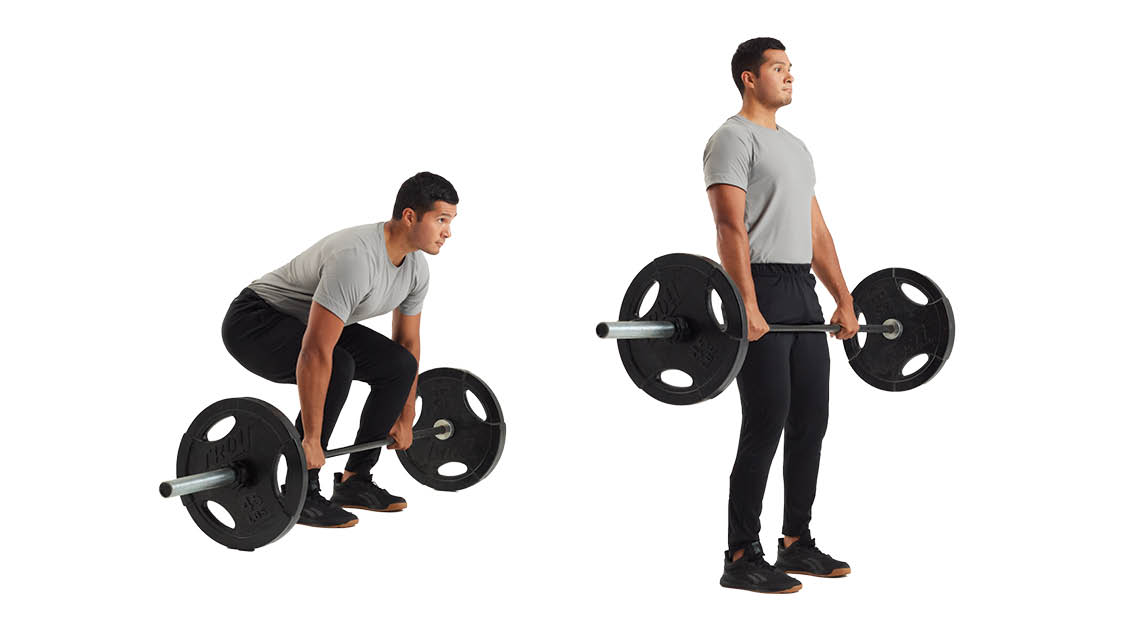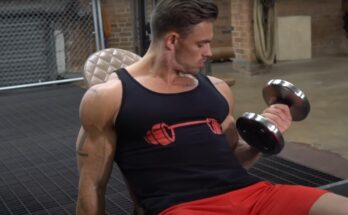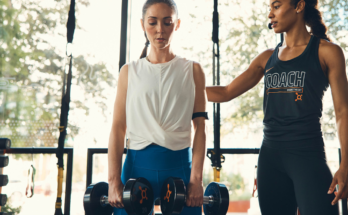The barbell deadlift is a compound exercise that targets multiple muscle groups. It primarily strengthens the lower back, glutes, and hamstrings.
The barbell deadlift is a foundational strength training exercise. It engages several major muscle groups, making it highly efficient for overall body development. Performing deadlifts improves posture, enhances grip strength, and boosts athletic performance. This exercise is also crucial for building a strong core and stabilizing the spine.
Deadlifts are versatile, allowing for various modifications to suit different fitness levels. Proper form is essential to avoid injuries and maximize benefits. Beginners should start with lighter weights and focus on technique. As strength improves, gradually increase the weight. Consistent practice of barbell deadlifts can lead to significant strength gains and improved functional fitness.

Credit: www.youtube.com
Introduction To Barbell Deadlift
The Barbell Deadlift is a powerful exercise. It builds muscle and strength. Many athletes include it in their routines. This exercise targets multiple muscle groups. You can improve overall fitness with it.
Importance Of Deadlifts
Deadlifts are essential for fitness. They work the legs, back, and core. They also improve posture. Lifting heavy weights increases strength. It boosts muscle growth too.
- Strength: Deadlifts make you stronger.
- Posture: They help improve your posture.
- Muscle Growth: They promote muscle growth.
- Core Stability: They enhance core stability.
Historical Background
The Deadlift has a rich history. Ancient warriors practiced lifting heavy stones. They believed it made them strong. The modern deadlift evolved from these practices. It became a staple in weightlifting competitions.
| Era | Activity |
|---|---|
| Ancient Times | Lifting heavy stones |
| Early 20th Century | Deadlift in competitions |
| Modern Day | Popular exercise in gyms |
Muscles Worked
The barbell deadlift is a powerhouse exercise. It targets multiple muscle groups, helping you build strength and size. Understanding the muscles worked can enhance your training efficiency.
Primary Muscles
The primary muscles engaged during a barbell deadlift include:
- Gluteus Maximus: These are your glutes, the muscles of your buttocks. They power your hip extension.
- Hamstrings: Located at the back of your thighs, they aid in hip extension and knee flexion.
- Erector Spinae: These muscles run along your spine. They keep your back straight and stable.
- Quadriceps: Found at the front of your thighs, they help in knee extension.
Secondary Muscles
Several secondary muscles assist in the barbell deadlift:
- Latissimus Dorsi: These large back muscles help in shoulder extension and stabilization.
- Trapezius: Located in your upper back and neck, they assist in shoulder stability.
- Forearms: These muscles are crucial for gripping the barbell securely.
- Core Muscles: Includes the abdominals and obliques. They stabilize your trunk throughout the lift.
| Muscle Group | Function |
|---|---|
| Gluteus Maximus | Hip extension |
| Hamstrings | Hip extension, knee flexion |
| Erector Spinae | Back stability |
| Quadriceps | Knee extension |
| Latissimus Dorsi | Shoulder extension, stabilization |
| Trapezius | Shoulder stability |
| Forearms | Grip strength |
| Core Muscles | Trunk stabilization |
Proper Technique
The barbell deadlift is a fundamental exercise for strength training. Mastering the proper technique ensures safety and maximizes effectiveness. This guide will walk you through each phase of the deadlift.
Starting Position
Begin with your feet hip-width apart. Place the barbell over the middle of your feet. Your toes should point slightly outward. Grip the bar with your hands just outside your knees. Keep your back straight and your chest up. Engage your core and keep your shoulders slightly in front of the bar.
| Key Points | Details |
|---|---|
| Foot Position | Hip-width apart |
| Hand Grip | Just outside knees |
| Back Position | Straight |
| Core | Engaged |
Lifting Phase
Drive through your heels to lift the bar. Keep the bar close to your body. Maintain a straight back and keep your chest up. Extend your hips and knees simultaneously.
- Drive through heels
- Keep bar close to body
- Maintain straight back
- Extend hips and knees
Lockout Phase
Stand up straight with the barbell. Lock your knees and hips. Pull your shoulders back slightly. At the top, your body should be in a straight line. Avoid leaning back or forward.
- Stand straight
- Lock knees and hips
- Pull shoulders back
Lowering Phase
Lower the bar by pushing your hips back. Keep the bar close to your body. Bend your knees slightly as the bar passes them. Keep your back straight throughout the movement.
- Push hips back
- Keep bar close
- Bend knees slightly
- Maintain straight back
Common Mistakes
Barbell Deadlift is a great exercise for strength. Many people make common mistakes. These mistakes can lead to injury and less progress. Let’s look at some common mistakes and how to avoid them.
Rounded Back
A rounded back is a common mistake. It puts stress on your spine. Keep your back straight to avoid injuries.
- Engage your core muscles.
- Maintain a neutral spine.
- Look forward, not down.
Incorrect Grip
Your grip affects your performance. An incorrect grip can lead to dropped weights.
| Grip Type | Benefits |
|---|---|
| Overhand Grip | Evenly distributes weight. |
| Mixed Grip | Prevents bar from rolling. |
| Hook Grip | Strong and secure hold. |
Choose a grip that suits you. Keep it firm and secure.
Lifting With Legs
Lifting with your legs is a big mistake. It uses the wrong muscles.
- Bend at the hips.
- Engage your core and back.
- Lift with your back and glutes.
Use the right muscles for a safe lift. Engage your whole body for balance and power.
Variations Of Deadlifts
The barbell deadlift is a fundamental exercise in strength training. There are many variations of deadlifts to target different muscles. Each variation has its own unique benefits and techniques. Understanding these variations can help you achieve better results.
Sumo Deadlift
The sumo deadlift has a wider stance and a narrower grip. This position engages the inner thighs and glutes more.
- Stand with feet wider than shoulder-width apart.
- Grip the barbell inside your knees.
- Keep your back straight and chest up.
- Lift the bar by pushing through your heels.
This variation is great for those with limited hip mobility. It also reduces stress on the lower back.
Romanian Deadlift
The Romanian deadlift focuses on the hamstrings and lower back. It uses a shorter range of motion than the traditional deadlift.
- Start with feet hip-width apart.
- Hold the barbell with an overhand grip.
- Keep your knees slightly bent.
- Lower the bar by pushing your hips back.
- Stop when your torso is parallel to the ground.
- Return to the starting position by thrusting your hips forward.
This variation helps improve hip hinge mechanics. It also strengthens the posterior chain.
Trap Bar Deadlift
The trap bar deadlift uses a hexagonal bar. This allows you to stand inside the bar, which changes the movement pattern.
- Stand inside the trap bar with feet shoulder-width apart.
- Grip the handles on each side.
- Keep your back straight and chest up.
- Lift the bar by pushing through your heels.
This variation is easier on the lower back. It’s also great for beginners who need to learn proper form. Each deadlift variation targets different muscle groups. Adding these variations to your routine can enhance your strength and muscle growth.

Credit: experiencelife.lifetime.life
Programming For Deadlifts
Barbell deadlifts are a cornerstone exercise for building strength. Proper programming is essential to maximize gains and avoid injury. This section will guide you through reps, sets, progression strategies, and how to incorporate deadlifts into your routine.
Reps And Sets
Choosing the right reps and sets is crucial. For beginners, starting with 3 sets of 5 reps is ideal. This builds a solid foundation and perfects form. Intermediate lifters can aim for 4 sets of 6-8 reps. Advanced lifters might consider 5 sets of 3-5 reps, focusing on maximum strength.
| Experience Level | Sets | Reps |
|---|---|---|
| Beginner | 3 | 5 |
| Intermediate | 4 | 6-8 |
| Advanced | 5 | 3-5 |
Progression Strategies
Progressing in deadlifts involves gradually increasing weight. A common strategy is the 5×5 method. Add 2.5-5 lbs each week. Another method is the linear progression. Increase weight every session until you hit a plateau. Deload by reducing weight by 10-20%, then build back up.
- 5×5 Method: Add 2.5-5 lbs weekly
- Linear Progression: Increase every session
- Deloading: Reduce weight by 10-20%, then build up
Incorporating Into Routine
Deadlifts should be part of a balanced routine. Perform them at the start of your workout. This ensures you have maximum energy. Pair deadlifts with accessory exercises like rows and planks. This helps build supporting muscles. Schedule deadlifts 1-2 times per week. Allow for rest days in between to recover.
- Perform deadlifts at the start of your workout
- Pair with accessory exercises like rows and planks
- Schedule deadlifts 1-2 times per week
- Ensure rest days for recovery
Safety Tips
Barbell Deadlifts are a powerful exercise for building strength. However, safety is key to prevent injuries. Follow these safety tips to ensure a safe and effective workout.
Warm-up Exercises
Always start with warm-up exercises. A good warm-up prepares your muscles and joints. It increases blood flow and reduces the risk of injury.
- Do light cardio for 5-10 minutes.
- Perform dynamic stretches targeting the lower body.
- Include bodyweight squats and lunges.
Using A Belt
Using a belt can provide extra support to your lower back. It helps maintain proper form, especially during heavy lifts.
- Choose a belt that fits snugly around your waist.
- Position the belt above your hip bones.
- Ensure it’s tight but not too restrictive.
Avoiding Overtraining
Overtraining can lead to fatigue and injuries. It’s essential to listen to your body.
| Signs of Overtraining | Recommendations |
|---|---|
| Persistent muscle soreness | Take rest days between sessions. |
| Decreased performance | Reduce the weight or volume. |
| Fatigue | Ensure adequate sleep and nutrition. |
Incorporate rest days into your routine. This allows your body to recover and grow stronger.

Credit: m.youtube.com
Benefits Of Deadlifting
The benefits of deadlifting are numerous and impactful. This exercise is a cornerstone of many strength training programs. It’s not just about lifting heavy weights. Deadlifting offers a range of advantages that enhance overall health and fitness.
Strength Gains
Deadlifting targets multiple muscle groups. These include your back, glutes, and legs. This compound movement is effective for building total-body strength. By regularly deadlifting, you can increase your overall power. It’s a great way to improve your athletic performance.
Improved Posture
Many people suffer from poor posture. This is due to long hours of sitting. Deadlifting can help correct this issue. The exercise strengthens your back muscles. This support helps keep your spine aligned. Better posture reduces the risk of injuries and pain.
Increased Metabolism
Deadlifting boosts your metabolism significantly. This is because it engages large muscle groups. More muscle mass means your body burns more calories. Even at rest, you’ll have a higher metabolic rate. This can aid in weight management and fat loss. Here’s a quick comparison of benefits:
| Benefit | Details |
|---|---|
| Strength Gains | Builds total-body strength and power. |
| Improved Posture | Strengthens back muscles, aligns spine. |
| Increased Metabolism | Boosts calorie burn, aids in fat loss. |
Equipment Needed
To perform a barbell deadlift safely and effectively, you need the right equipment. Proper gear ensures you can lift with correct form and minimize injury risk. Here’s a breakdown of what you’ll need:
Choosing A Barbell
A standard barbell is essential for deadlifting. Choose a bar that is comfortable to grip. Most barbells weigh 20 kg (44 lbs). Ensure the barbell has good knurling. Knurling helps your hands grip the bar better.
Weight Plates
You will need weight plates to add resistance to your barbell. Weight plates come in various sizes. Common weights are 5 kg, 10 kg, and 20 kg. You can use a mix of plates to achieve your desired weight.
| Weight Plate | Weight (kg) |
|---|---|
| Small Plate | 5 kg |
| Medium Plate | 10 kg |
| Large Plate | 20 kg |
Flooring And Mats
Deadlifting requires a strong surface. Use rubber mats to protect your floor. Rubber mats absorb impact and reduce noise. They also provide a stable surface. Ensure your mat is at least 1 inch thick. This thickness protects both your floor and your equipment.
- Rubber mats
- Stable surface
- 1 inch thickness
With the right equipment, you can safely perform barbell deadlifts. Invest in quality gear to enhance your lifting experience.
Frequently Asked Questions
What Muscles Do Barbell Deadlifts Work?
Barbell deadlifts primarily target the lower back, glutes, and hamstrings. They also engage the core, quads, and upper back. This makes them a comprehensive strength-building exercise.
How To Perform A Barbell Deadlift Correctly?
Start with feet hip-width apart. Grip the barbell firmly. Keep your back straight and lift with your legs. Avoid rounding your back to prevent injury.
Are Barbell Deadlifts Good For Beginners?
Yes, beginners can benefit from barbell deadlifts. Start with lighter weights to learn proper form. Gradually increase the weight as you gain strength.
How Often Should I Do Barbell Deadlifts?
Perform barbell deadlifts 1-2 times per week. Allow adequate rest between sessions. This helps in muscle recovery and prevents overtraining.
Conclusion
Mastering the barbell deadlift can transform your fitness journey. This powerful exercise builds strength, improves posture, and enhances overall muscle development. Incorporate it into your routine for noticeable gains. Remember to maintain proper form to prevent injuries and maximize benefits.
Start lifting today and experience the difference in your workouts!



